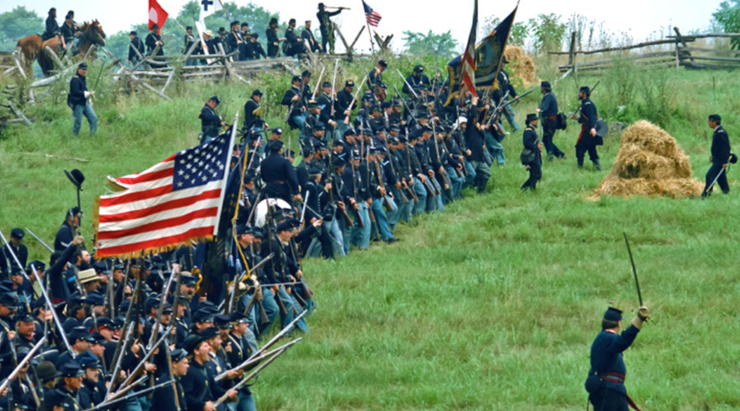|
Memorial Day was originally established to celebrate Civil War heroes in a single unified day, instead of separate days celebrated by the Union and Confederate states. Around the 19th century, Memorial Day expanded to celebrate all veterans who fought as American forces. As physicians, we learn from one another and are united in our thirst for knowledge to better serve humanity . War, in all its ugliness and chaos, demands innovation in science and technology. Thus, it is not surprising that modern medicine seems to have strong roots during times of war. The ancient philosophers and scientists created a foundation for physicians during the Civil War to innovate to meet the demands of its wounded soldiers, but also to create standards of care that we practice even today. Here are 5 innovations that were developed during the Civil War: 1. LIFE SAVING AMPUTATION - The old practice of saving limbs with wound cleaning using rats and maggots was replaced with cutting off infected limbs to prevent the spread of infection. In fact, Union soldiers were known for amputations, had less mortality from their procedures, and took no more than 6 minutes to perform. The technique not to cut through joints and to cut far away from the heart as possible became the standard of care. 2. THE ANESTHESIA INHALER - Stonewall Jackson's surgeon recommended the removal of his left arm after it was injured during friendly fire. When a chloroform-soaked cloth was placed over his nose, General Jackson muttered, "What an infinite blessing," before going limp. The cloth was inefficient as the liquid evaporated quickly, so Dr. Julian John Chisolm invented a 2.5 inch inhaler. Chloroform was dripped through a perforated circle on the side onto a sponge in the interior - the patient inhaled through tubes and the vapors mixed with air. This new method required less liquid; thus, allowing the physicians to treat more soldiers and using less supplies. 3. CLOSING CHEST WOUNDS - Benjamin Howard, an assistant surgeon, was told to do busy work while his superiors performed the surgeries. He started to experiment and realized that if he closed the chest with staples and linen, the lungs did not collapse as they did when the chest cavity is opened from negative pressure; thus, there was no suffocation. Survival rates quadrupled with this new technique. This technique became the standard treatment. 4. FASCIAL RECONSTRUCTION Dr. Gurdon Buck, father of modern plastic surgery, looked onto a young 20 year old private named Carleton Burgan of Maryland. This private had battled pneumonia and now the mercury pills had led to gangrene that was moving from his mouth to his eyes. His right cheekbone had to be removed and the young man was willing to try anything to stop the infection. Dr. Buck was the first to photograph his progress of his repairs and use tiny sutures to minimize scarring.
5. THE AMBULANCE-TO-ER SYSTEM - The Union went into the First Battle of Bull Run on July 21, 1861 not expecting a true battle. As approximately 1,011 Union soldiers lay wounded, the ambulances remained empty, leading to high numbers of mortality. The civilian drivers at the time were, according to some, described as "cowards" or "drunkards." Jonathon Letterman, the medical director of the Army of the Potomac, created a model of triage that we all know today. He established caravans of 50 ambulances, each with a driver and 2 stretcher bearers. He hired private wagons to carry medical supplies. The ambulances had spring suspensions and a lock box to prevent soldiers from stealing protein, bedsacks, and morphine that was reserved for the injured. Every war brings innovation and the medical community must not forget the sacrifices made by soldiers, scientists, physicians, and several other professionals who made modern day medicine what it is today. In this reflection, we must ask the question, have we been effective in preserving that fundamental drive that our predecessors had to innovate to help a large number of people without regard to creating any complex systems that may interfere in allowing the injured to access the innovation? Memorial Day should make all of us pause and reflect on the many lessons learned across all professions during our times of war. What is even more fascinating is that those lessons continue to teach us today; regardless of how advanced we think we are as a society. In loving memory of all fallen soldiers, Dr. Ahmed
0 Comments
Your comment will be posted after it is approved.
Leave a Reply. |
Author"He who studies medicine without books sails an uncharted sea, but he who studies medicine without patients does not go to sea at all." Archives
March 2023
Categories
All
|
We are passionate about practicing medicine
|
|
CLINIC HOURS
MONDAY 9am-5pm TUESDAY 9am -5pm WEDNESDAY 9am-5pm THURSDAY 9am-5pm FRIDAY 9am-12pm Closed 12pm-1pm daily for lunch SAT&SUN CLOSED |
2024 Holidays - CLINIC CLOSED
New Year's - January 1st Memorial Day - May 27 Independence Day - July 4 & 5 Labor Day - September 2 Thanksgiving - Nov 27, 28 & 29 Christmas - December 24, 25 & 26 |
Contact Us
Tel: (913) 549-3884
Fax: (913) 273-3343
Email: [email protected]
6650 West 110th Street
Suite 220 A
Overland Park, KS 66211
Fax: (913) 273-3343
Email: [email protected]
6650 West 110th Street
Suite 220 A
Overland Park, KS 66211



 RSS Feed
RSS Feed